‘One may see Shibumi as submission, another may see Shibumi as power.
Nonetheless, one does not acheive Shibumi, one discovers it.” —Trevanian
We missed Lake Sylvia. Motored right by. We didn’t know it at the time, but the universe had something better lined up.
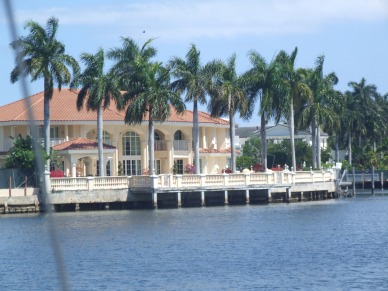
LaDeeDah Landscape: The waterfront palaces that line the canals of Lauderdale are ripe for gawking. Maybe that’s why we missed the turn into Lake Sylvia.
We were feeling testy, Captain Scott and I, after a day on Florida’s East Coast Intracoastal Waterway featuring several timed drawbridges and a vigorous keel-sanding near Bakers Haulover Inlet, where every inch of our 32-foot DownEast Chip Ahoy’s five-foot draft was keenly felt as we plowed along the rim of unavoidable, channel-encroaching, deceptively pretty shoals.
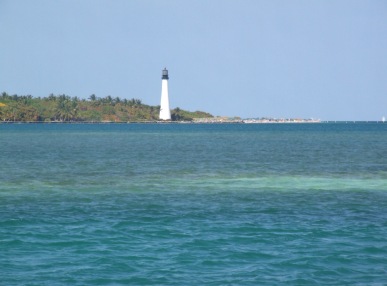
Cape Florida Light on Key Biscayne. You clearly see the shoals (brown brown run aground) between the two channels leading into the bay.
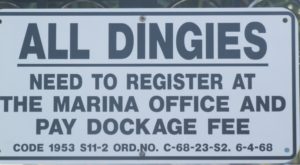
An editor is never off duty: Egregious spelling noted in Dinghyland (resisting urge to correct with Sharpie).
Northbound from Marathon, we’d spent the previous night at our favorite anchorage off Key Biscayne near former President Richard Nixon’s “Winter White House,” close to the 1970s residence of his millionaire buddy, Cuban-American banker Bebe Rebozo. It’s a spectacular vantage point open to the Miami skyline as well as Spring Break capers of youngsters playing in their runabouts. Our own party started when Scott hoisted his homemade circular antenna to draw in the first on-board live TV in months.
We considered dawdling on Biscayne, but an Indiantown boatyard appointment beckoned. Before noon the next day we were headed up the inside track, passing through the ICW condo canyons that Scott sings about in his song “La Dee Dah,” an ode to the water trail from Miami to Fort Lauderdale.
Earlier we’d called the City of Fort Lauderdale’s Las Olas Marina (954-828-7200) and learned none of the 10 highly coveted balls tucked in the western notch on the south side of the Las Olas Boulevard lift bridge were available.
The Lake Sylvia anchorage was a much-anticipated back-up. Local sailors Derek and Diane recommended it, assuring it was deep enough and that water cop harassment of yore was no more. But we missed the couple as well as the anchorage; they were delivering a sailboat to Kemah, Texas.
“OK. What’s the next place to anchor after this bridge?” Scott asked. We weren’t going back to the bay. Too many bridges. And neither one of us likes to turn around. I sighed, picking up the radio mike to hail for the Las Olas bridge opening schedule.
“It’s David and Jill,” Scott announced matter-of-factly, as if he’d expected them to materialize. The Palm Coast couple, crew of the 44-foot CSY sailing vessel Shibumi, beamed smiles at us from their dinghy as they crossed Chip Ahoy’s bow. They were returning from a beach walk, where they’d been enjoying spring-break action on Lauderdale’s exuberant strip.
“That ball is open,” David pointed to the mooring closest to the bridge and next to Shibumi in the “field” a rather grandiose term for tiny cul de sac bordered by a pocket park at the foot of the bridge. Current is fierce. There would be time later to marvel over the timing; first we had to wrangle a ball. David and Jill assisted from the dinghy. I let the bridge tender know we wouldn’t need an opening after all.
We’d hoped to meet the couple somewhere during our travels over the winter but by March assumed our ships had passed, as happened the previous two years. In retrospect the synchronicity some call coincidence is one of the things we most appreciate about cruising life: Joyful meetings materializing when least expected.
These kind, funny, smart, serene and dynamic Tai Chi-practicing retired air traffic controllers have turned going-with-the-flow into an art form.
“We could go grab a burger somewhere, or would you rather eat on the boat?” Jill asked.
Whenever Jill volunteers to prepare a meal the answer is always “Yes, please!” Over pear sake and spicy shrimp gumbo we caught up on their travels down the east coast and our trek up from Marathon, where we’d been residents of Boot Key Harbor mooring field for six weeks. That’s where we met David and Jill in 2011, bonding over Scott’s mother’s cranberry-walnut Christmas bread.
The tedium of 10 drawbridges (counting the 55-foot 17th Street Bridge that didn’t have to rise for us) faded for me as we gabbed about up-bound passage. I was still under the spell of the underwater gardens blooming with life on the stretch from Rodriguez Key to Miami. There wasn’t enough breeze to sail. Clarity was Neptune’s consolation prize. The still, crystalline sea-window revealed stretching starfish and urn-shaped sea plants undulating in a gentle current. Turtles, dolphins and silver schools of small fry flashed by, their shadows reflected on the rippled white-sand bottom. I found it difficult to mind the markers, so entrancing was the living garden below.
I hear plans are afoot to dredge off Miami to allow for commercial shipping traffic. Terrible idea. This region is far more pristine and fragile than you know unless you’ve been out on a day like that day.
Getting There: Finding Shibumi
We, or to be more accurate I, have always wanted to go ashore to experience some of Miami and Miami Beach’s most iconic landmarks, including the chic South Beach promenade and historic Coconut Grove. I’d hoped that this time rather than anchoring off Key Biscayne, just outside tiny Hurricane Harbor, we could grab a municipal mooring ball at the grove and then perhaps enjoy another day anchored over by Star and Monument Islands, where it’s an easy dinghy ride to an impromptu South Beach landing spot (locking the inflatable, of course). If we stayed longer, perhaps we could even revisit the Publix grocery store accessible by the Venetian canals. We heard the dinghy dock there had greatly improved.
But the strong northeast wind picking up and forecast to build didn’t work in my favor. Fingers crossed, I’d called Florida’s largest marina, at Dinner Key, as we wound along the Biscayne channel, which splits off from the Cape Florida channel that runs right along the historic lighthouse at Bill Baggs State Park. That route is preferred for ducking into the park’s teeny No Name Harbor. We’ve never stayed there and can’t speak to the truth of the stories we’ve heard about noise and crowds. In any case it wouldn’t be an anchorage we’d be willing to try during spring break, although the park amenities are an attractive lure.
We hadn’t visited Stiltsville since 2005. There are still seven homes standing, down from the more than two dozen that lined Biscayne channel in the 1960s, when this most unique of neighborhoods was at its peak. Part of Biscayne National Park, the homes now serve as colorful back-up markers to the red-right-returning system. You can take a guided tour and they are sometimes used for special events but are no longer occupied.
We always go into Miami via Biscayne Bay. Further up there’s the main shipping channel, Government Cut. If you choose to enter this way, monitor the radio to ensure it’s free and clear of outgoing or inbound cruise ships and other commercial traffic that for homeland security reasons may limit recreational vessel traffic.
I phoned Dinner Key Marina to check on mooring ball availability just as Chip Ahoy entered Biscayne Channel. We wouldn’t make it before 5 p.m. No problem, said the friendly, easygoing Miami Municipal Marina staffer who assigned us a ball and provided detailed directions into the mooring field. It’s bordered by a substantial shoal area, aka “Wake Island,” that must be skirted rather than taking a direct path.
The mirror-glass calm disappeared, yielding to whitecaps as we worked our way up the bay. When it came to port or starboard at channel’s end our natural inclination was to hang a right, bypassing the mooring field in favor of the sheltered, familiar anchorage we’ve successfully used twice in the past. It would turn out to be a wise decision. When we remarked at how inexpensive Dinner Key mooring fees are – in spring 2014 $22.20 per night – David and Jill said they ought to be cheaper, given the misery of the rolling that occurs as the field receives the full brunt of the large bay’s eastern fetch.
The crescent-shaped shoal that breaks bay waters just outside Hurricane Harbor is a day-magnet low-tide sand bar for spring breakers. There’s no chance of grounding as bikini-clad babes, all the young dudes and pumping dance music clearly show where not to go. As always, water police kept a watchful eye on the scene. We saw them interfere just once, leading an overloaded ski boat and its occupants back to a nearby marina.
You can nose into the enclosed protection of Hurricane Harbor. Many boats do. The circlet offers no shore access and you’re up close and personal with the opulent mansions of Key Biscayne in a way that feels almost claustrophobic and slightly invasive, i.e. everyone can look in everyone’s windows. We anchored there during our first loop, following the lead of a veteran cruiser, Tom of the CSY Destiny’s End, who bemoaned the good ol’ days when cruisers could land dinghies on vacant lots or construction sites in the exclusive community. On that trip we’d tied our dinks to the foot of an arching pink-stucco bridge, climbed it and walked past eye-popping mansions and fairy-tale landscaping to the most upscale and only non-English speaking Publix I’ve ever seen. The foray into Cuban Shangri La ended abruptly when we were forced to rappel down the bridge with grocery bags, avoiding slicing ourselves or the inflatables on the masses of razor barnacles exposed at low tide.
While it had been eight years since Chip Ahoy cruised Florida’s East Coast, there was a comforting sameness to the scene, including the fixed-point previously used to ensure we weren’t dragging: the stately gray yacht Dorothy Ann, docked exactly where we’d last seen her.

Spring Break in Miami Beach always offers interesting people and boat watching. Spring breakers like to drop anchor and turn up the music.
At nightfall a blinged-out yacht parked near the party shoal, but soon the music stopped, replaced by a fireworks show over the Miami skyline. The next morning we lingered after breakfast, in no rush to begin our day of timed bridges, wherever that might take us: the Venetian Causeway and its anchorages, the snug-but-wakey Miami Stadium anchorage or somewhere farther afield, like, say, Lake Sylvia.
As we moved into the well-marked channel running close to downtown high rises and public parks we easily fell into the remembered rhythm of calling the bridges, waiting for the bridges and enjoying the sights. Boaters seemed more courteous than previous years, when we’d been unmercifully and purposely waked more than once, most memorably by a megayacht with a gaggle of bare-breasted Bond girls sunning on the foredeck and cheering on the shenanigans.
Our perception of a kinder, gentler ICW would be re-adjusted beyond Lauderdale, in the Boca Raton to Hobe Sound sector where the Weekend Wakers were as impudent as ever. But on this day Miami had cleaned up its vices.
We often marvel at having chosen the perfect boat for our chosen path during the past 19 years. Chip Ahoy’s 47-foot mast height permits access to inside routes crossed by fixed bridges. Shibumi for example, has a 65-foot mast and so is restricted by North Miami’s Tuttle Bridge. David and Jill take Shibumi out Lauderdale’s Port Everglades Inlet then back in if desired at Government Cut or Biscayne Bay.
But as we discovered, Bakers Haulover Inlet is the perfect illustration of why you shouldn’t go somewhere just because your mast height is acceptable. Draft matters, too. Chip Ahoy’s Memory Lane excursion turned shallow and ugly fast.
As I usually do in low-water situations I stood at the bow, to eyeball the shoals and avoid looking at the depth sounder. “To port, to port!” I hollered, pointing to the land side of the channel as my exasperated mate shouted back “I’m trying, I’m trying!” The commercial tow boat standing by with lights flashing was an indicator we weren’t being needlessly paranoid.
Captain Scott has passed his phase of enjoying a self-provoked adrenalin rush, such as doing the supposedly un-doable New Jersey ICW during our first America’s Great Circle Loop because the Skipper Bob guidebook said we shouldn’t. And I’ve never felt a need to challenge nature. With that in mind we’ll try to avoid Baker’s in the future.

Shibumi and Chip Ahoy side-by-side on moorings, something that last happened in Boot Key Harbor’s field several years ago.
Shibumi, a 1980 walk-over center-cockpit Caribbean Sailing Yacht, or CSY, had her own adventures sailing Florida’s East Coast, including a 19-hour night passage from the Fort Pierce to Port Everglade inlets under a three-quarter moon with kindly if not perfectly favorable sea conditions and a three-hour watch schedule.
Life Aboard an Elegant CSY
From the first time I stepped aboard a CSY – that would be Tom’s impeccably maintained 44-footer Destiny’s End —I’ve been a fan of the spacious, accessible design of these attractive vessels.
Shibumi’s identical layout features a salon and galley forward, along with a v-berth, head and separate shower. The master suite is aft, with adjacent head and shower. The navigation table is also handily located aft, adjacent to the cockpit.
Oh, that cockpit! Expansive seating makes CSYs the boat most likely to host the party in any harbor. That’s certainly the case aboard Shibumi, where fine dining rises to new heights thanks to customized, generously reconfigured freezer space and refrigeration designed and installed by SALT Services Inc. of Marathon.
Jill, a provisioning pro, organizes meals in advance using menu cards and pre-packed-by-month ingredient pouches. It’s a technique honed during years of cruising in the Bahamas, ensuring that every occasion, from Super Bowl potluck to intimate dinners, is covered.
“It’s all about the food,” Jill says, explaining that you’re better off taking some items with you because they’re either too expensive in the islands or unavailable, be that paper goods or a particular type of sugared almond.
Lauderdale is one of the couple’s favorite bases, for both its memories and current events. In 2004 they completed the bulk of Shibumi’s extensive refit here, based from a slip on the Isle of Venice. In those pre-dockominium days there were more private, affordable transient slips available.
Jill’s about-town expertise dates farther back, to her college days. The math major lived aboard a 65-foot sailboat while attending Florida Atlantic University.

Florida Atlantic University’s campus on the Riverwalk brings back college-day memories for Jill, who lived aboard while attending school here. Like Jill, FAU was ahead of its time, offering online access to some courses long before distance learning became commonplace.
Scott also spotted a landmark from that era: The Elbo Room, still going strong just across the street from the beach. Jill knew it as a popular college hangout. Scott remembers it from his time as a rock-and-roll guitarist on tour with a Michigan band. They played Lauderdale for 1970s spring break crowds at a beach bar. “I think it was called the Sea Mist,” he says. “We were on the same circuit as KC & The Sunshine Band and Miami Sound Machine.”
We stopped at Da Big Kahuna in the Beach Place galleries of shops and restaurants to satisfy burger & beer cravings (David was the healthy rebel, opting for broiled salmon and rice).
On the stroll home a flamenco guitarist at Café Del Mar pulled us into his stylish world. He was accompanied by an elegant, sinuous dancer, a whirl of colored scarves, her movements punctuated by castanets and heels. Spellbound, we watched for several minutes before moving along the packed promenade pulsing with Saturday night fever.
Tour (Unexpected) Downtown Fort Lauderdale
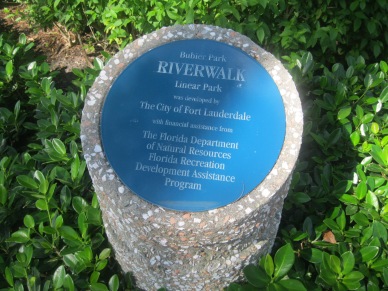
Green shady spaces on the Riverwalk offer a pleasing contrast to Lauderdale’s hot (in more ways than one) beaches.
It was one of several unexpected Lauderdale delights. The next day our savvy tour guides took us downtown. We hopped the uptown bus just outside the marina, then walked Las Olas Boulevard back. Nautical to artsy, this community is a place of many vibes. We followed Riverwalk over the railroad tracks to the Himmarshee district, one of three historical enclaves in the city featuring interesting examples of classic regional architecture. It’s an unexpected contrast to the McMansions gilding the ICW-adjacent canals with their golden statues and cascading fountains. A group of schoolchildren flocked on the lawn of the circa-1907 King-Cromartie House, a charming 1907 structure built from Dade County pine and salvaged ship’s timbers that was moved from its original spot on the New River to the historical society campus, which also includes the nearby Hoch Heritage Center and Philemon Bryan House, a hollow concrete structure. If like me you tend to think of “La Dee Dah” as Miami’s slightly less cultured new-money neighbor, this view of the city’s storied past, a far cry from thongs and bongs, is sure to surprise.

Historic sights: Students take in a re-enactment of the olden days in Lauderdale’s historic district.
There’s another municipal city marina around the New River Bend. Though the facility looks inviting there’s no way I’d take Chip Ahoy upriver, not after watching an outflow pipe gush, raising the water level as vessels waited 15 minutes or more for a railroad bridge, one of three opening bridges that would be difficult to deal with in strong current accompanied by a steady stream of power boats and water taxis.

Water pours out as one of the three lift bridges on the New River in downtown Fort Lauderdale rises. Can’t say I’d be comfortable trying to maneuver a 32-foot sailboat amidst the man-made and natural currents in this busy, narrow stretch of waterway.
On our amble back to the boats we gazed into downtown window displays, taking in a mélange of main-street shops, cafés and galleries. Jill pointed out Isle of Venice, where the couple lived aboard Shibumi for more than a month before their maiden voyage to the Keys.
David, a native New Yorker and Vietnam veteran acquired his air-traffic control skills during his U.S. Air Force service. A member of the 1970 FAA Academy’s graduating class, David wrapped up a 38-year career in 2004. He was based in Atlanta, where he met soulmate Jill, who also retired, after a 22-year career. Bearing a striking resemblance to Glinda the Good Witch, there’s magic in Jill’s smile as well as her ability to make everything from appetizers to home décor look lovely and effortless.
Jill designed and sewed the full enclosure, with its dozens of options for letting in the right combination of breezes. She’s made repairs to it but frankly admits it’s a project she’s never going to tackle again. The couple also laughed about having their brightwork varnished before their latest cruise – only to inadvertently power-wash it off.
We talked about sailing the Atlantic together. The weather didn’t cooperate. Chip Ahoy continued up the ICW the next morning; Shibumi opted to wait. We’re grateful for the Lauderdale orientation. We’ll be back. Maybe next time Derek and Diane will be around and we’ll all anchor in Lake Sylvia.
What is Shibumi?
There are several interpretations for the Japanese phrase, which is also the title of a 1979 novel by Rodney William Whitaker, who wrote several books under the pen name Trevanian. David and Jill’s favorite definition of Shibumi is “eloquent silence.”
Shibumi also is:
- The subtle, simple beauty of Jill in her signature Dorfman Pacific big-brim cotton canvas sunhats.
- The co-mingling of technology and nature in David’s photography, shot with techniques detailed in his limited edition Capture, Edit, Share, the primer he wrote and published covering the nuances of iPhoneography.
- Freshly baked warm apple dumplings topped with vanilla ice cream, shared on a blustery winter evening, or homemade kettle corn in the stovetop popper – Jill’s ultimate after-dinner comfort snacks.
- A neat shot of Nassau Royale, vanilla-infused sipping rum, savored in the CSY’s peaceful cockpit while watching a moonrise.

Fort Lauderdale City Marina was offering winter dockage rates below $2 per foot for cruising size vessels from 30-to-49 feet in 2014. Rates are even less expensive at the New River/Downtown Docks and the Cooley’s Landing Marina. E-mail marinas@fortlauderdale.gov or call Las Olas Marina at 954-828-7200 for current info.
In our dinghy Snowflake, tender to Chip Ahoy, on Las Olas mooring field. Grateful to David for the shots—one of which appeared in Sailling Magazine.Cyndi Perkins is a writer, editor and sailor who travels the Eastern U.S. aboard her 32-foot DownEast Chip Ahoy with harbormaster husband Scott. Her debut novel, “More Than You Think You Know,” a nautical adventure about three renegade women, a 44-foot yacht and 1,000 miles of river, was released by Beating Windward Press in 2017.
Listen to the Scott Perkins original La Dee Dah on Spotify, iTunes or at http://www.reverbnation.com/scottperkins
David and Jill’s cruising adventures are chronicled on the Facebook Page “In Search of Shibumi.” They recently made a decision to put her on the market. “We hope to find new owners who will love her as much as we do,” he writes.

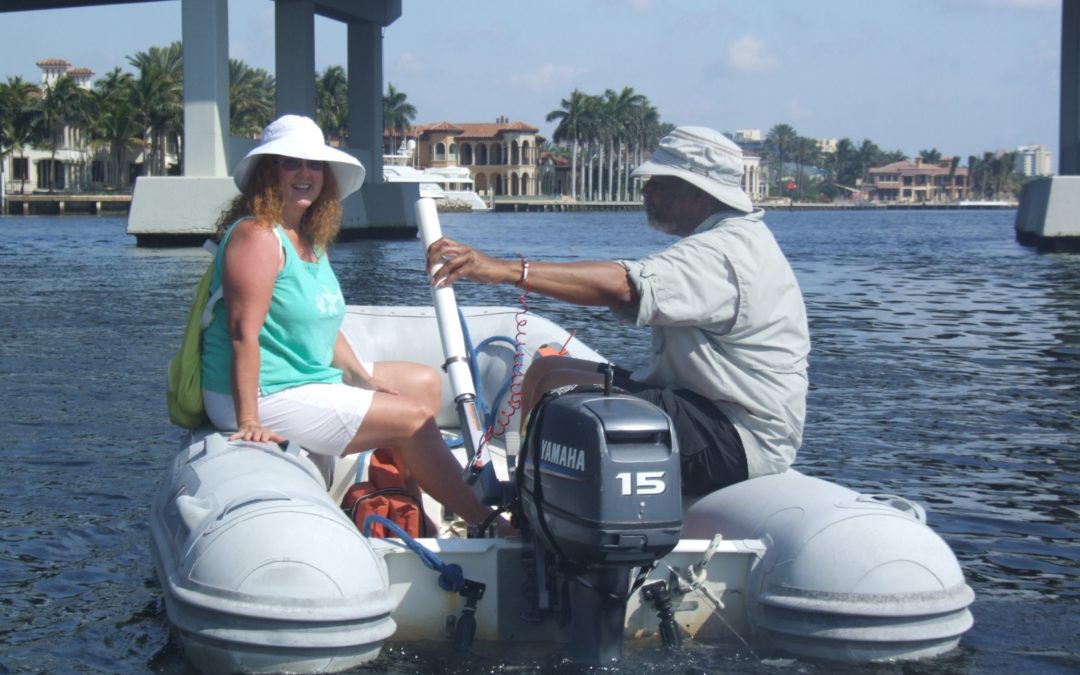






Recent Comments